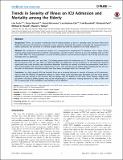| dc.contributor.author | Fuchs, Lior | |
| dc.contributor.author | Novack, Victor | |
| dc.contributor.author | McLennan, Stuart | |
| dc.contributor.author | Baumfeld, Yael | |
| dc.contributor.author | Park, Shinhyuk | |
| dc.contributor.author | Howell, Michael D. | |
| dc.contributor.author | Talmor, Daniel S. | |
| dc.contributor.author | Celi, Leo Anthony G. | |
| dc.date.accessioned | 2014-06-30T12:57:31Z | |
| dc.date.available | 2014-06-30T12:57:31Z | |
| dc.date.issued | 2014-04 | |
| dc.date.submitted | 2013-11 | |
| dc.identifier.issn | 1932-6203 | |
| dc.identifier.uri | http://hdl.handle.net/1721.1/88116 | |
| dc.description.abstract | Background:
There is an increase in admission rate for elderly patients to the ICU. Mortality rates are lower when more liberal ICU admission threshold are compared to more restrictive threshold. We sought to describe the temporal trends in elderly admissions and outcomes in a tertiary hospital before and after the addition of an 8-bed medical ICU.
Methods:
We conducted a retrospective analysis of a comprehensive longitudinal ICU database, from a large tertiary medical center, examining trends in patients’ characteristics, severity of illness, intensity of care and mortality rates over the years 2001–2008. The study population consisted of elderly patients and the primary endpoints were 28 day and one year mortality from ICU admission.
Results:
Between the years 2001 and 2008, 7,265 elderly patients had 8,916 admissions to ICU. The rate of admission to the ICU increased by 5.6% per year. After an eight bed MICU was added, the severity of disease on ICU admission dropped significantly and crude mortality rates decreased thereafter. Adjusting for severity of disease on presentation, there was a decreased mortality at 28- days but no improvement in one- year survival rates for elderly patient admitted to the ICU over the years of observation. Hospital mortality rates have been unchanged from 2001 through 2008.
Conclusion:
In a high capacity ICU bed hospital, there was a temporal decrease in severity of disease on ICU admission, more so after the addition of additional medical ICU beds. While crude mortality rates decreased over the study period, adjusted one-year survival in ICU survivors did not change with the addition of ICU beds. These findings suggest that outcome in critically ill elderly patients may not be influenced by ICU admission. Adding additional ICU beds to deal with the increasing age of the population may therefore not be effective. | en_US |
| dc.language.iso | en_US | |
| dc.publisher | Public Library of Science | en_US |
| dc.relation.isversionof | http://dx.doi.org/10.1371/journal.pone.0093234 | en_US |
| dc.rights | Creative Commons Attribution | en_US |
| dc.rights.uri | http://creativecommons.org/licenses/by/4.0/ | en_US |
| dc.source | Public Library of Science | en_US |
| dc.title | Trends in Severity of Illness on ICU Admission and Mortality among the Elderly | en_US |
| dc.type | Article | en_US |
| dc.identifier.citation | Fuchs, Lior, Victor Novack, Stuart McLennan, Leo Anthony Celi, Yael Baumfeld, Shinhyuk Park, Michael D. Howell, and Daniel S. Talmor. “Trends in Severity of Illness on ICU Admission and Mortality Among the Elderly.” Edited by William Alazawi. PLoS ONE 9, no. 4 (April 3, 2014): e93234. | en_US |
| dc.contributor.department | Massachusetts Institute of Technology. Institute for Medical Engineering & Science | en_US |
| dc.contributor.department | Harvard University--MIT Division of Health Sciences and Technology | en_US |
| dc.contributor.mitauthor | Celi, Leo Anthony G. | en_US |
| dc.contributor.mitauthor | Park, Shinhyuk | en_US |
| dc.relation.journal | PLoS ONE | en_US |
| dc.eprint.version | Final published version | en_US |
| dc.type.uri | http://purl.org/eprint/type/JournalArticle | en_US |
| eprint.status | http://purl.org/eprint/status/PeerReviewed | en_US |
| dspace.orderedauthors | Fuchs, Lior; Novack, Victor; McLennan, Stuart; Celi, Leo Anthony; Baumfeld, Yael; Park, Shinhyuk; Howell, Michael D.; Talmor, Daniel S. | en_US |
| mit.license | PUBLISHER_CC | en_US |
| mit.metadata.status | Complete | |
